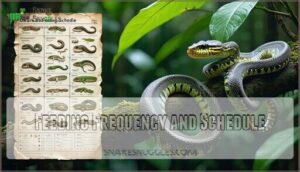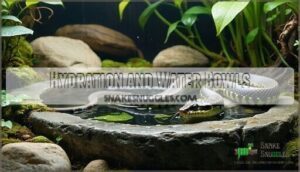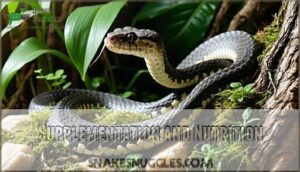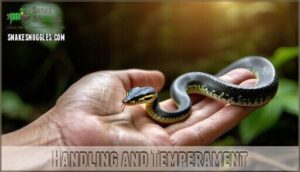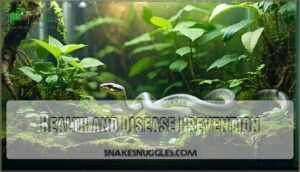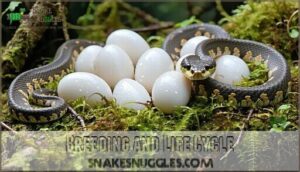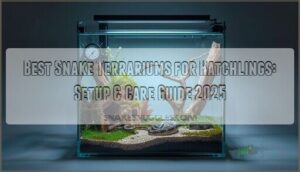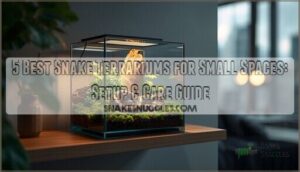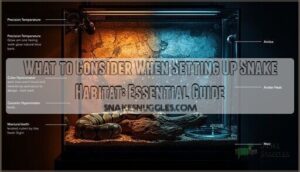This site is supported by our readers. We may earn a commission, at no cost to you, if you purchase through links.
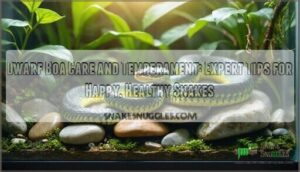 You’ll find that dwarf boa care and temperament require patience and precision.
You’ll find that dwarf boa care and temperament require patience and precision.
These compact constrictors need temperatures between 85-90°F with careful thermal gradients, unlike their larger cousins who tolerate heat better.
Your dwarf boa won’t be as laid-back as common boas initially, but they’re surprisingly docile once trust develops.
Avoid touching their heads during the first few weeks while they adjust.
They prefer staying cooler than expected and need consistent, gentle handling to build confidence.
With proper environmental conditions and gradual socialization, you’ll discover why experienced keepers treasure these intermediate-level snakes.
The key lies in understanding their specific seasonal needs and unique behavioral patterns.
Table Of Contents
- Key Takeaways
- Dwarf Boa Habitat Needs
- Feeding Dwarf Boas
- Handling and Temperament
- Health and Disease Prevention
- Breeding and Life Cycle
- Frequently Asked Questions (FAQs)
- What is the temperament of a dwarf boa?
- Are dwarf boas easy to care for?
- What is the friendliest boa?
- Are boas aggressive to humans?
- What morphs are available for dwarf boas?
- How much do dwarf boas typically cost?
- Are dwarf boas legal in all states?
- Can dwarf boas live with other snakes?
- How long do dwarf boas usually live?
- Conclusion
Key Takeaways
- You’ll need precise temperature control – maintain 85-90°F basking spots with proper gradients, as dwarf boas are more sensitive to heat fluctuations than larger boa species.
- Start handling early but go slow – begin socialization within the first month with short 10-minute sessions, as these snakes can be defensive initially but become docile with consistent, gentle interaction.
- Create proper humidity levels of 60-70% – use cypress mulch or coconut fiber substrate to maintain moisture for healthy shedding, and provide fresh water bowls for soaking.
- Feed appropriately sized prey every 7-14 days – hatchlings need weekly meals, while adults eat every 10-14 days, using frozen-thawed mice matched to your snake’s size to prevent injury and overfeeding.
Dwarf Boa Habitat Needs
If you want your dwarf boa to thrive, you’ll need to create a habitat that matches its natural environment as closely as possible, paying careful attention to enclosure size, temperature, humidity, and hiding places.
By providing the right setup, you help guarantee your snake stays healthy, active, and stress-free.
Enclosure Size and Type
Choosing the right dwarf boa enclosure means matching tank dimensions to your snake’s adult size.
Aim for at least a 36x18x18-inch tank for one boa.
Material safety matters—glass or PVC enclosures work well.
Consider an arboreal setup if your boa likes to climb.
Bioactive enclosures boost enrichment, while enclosure security keeps escape artists safe.
Many owners buy specialized boa products to guarantee a perfect fit.
Prioritize comfort for ideal dwarf boa care.
Temperature and Lighting Requirements
Once your dwarf boa enclosure is set up, dial in the temperature and lighting. A proper heat gradient lets your snake self-regulate, like lounging in a cozy Basking Spot or retreating to cooler zones.
Don’t forget:
- Night Temperatures: 72–75°F
- Basking Spot: 88–92°F
- UVB Lighting: optional, low intensity
- Temperature Monitoring: digital tools
- Stable heat sources
Selecting the correct basking bulb options is important for your boa to have a proper heat gradient.
Humidity and Substrate Options
After sorting your dwarf boa’s temperature, it’s time to talk humidity control. Aim for 60–70% humidity in your dwarf boa enclosure to support shedding success and healthy skin.
Choose substrate types like cypress mulch or coconut fiber, which help with mold prevention and burrowing behavior. One key benefit is humidity retention properties.
Here’s a quick guide:
| Substrate Type | Humidity Control |
|---|---|
| Cypress Mulch | Excellent |
| Coconut Fiber | Very Good |
| Aspen Shavings | Poor |
| Paper Towels | Low |
Hiding Places and Decoration
Even a shy dwarf boa appreciates a well-furnished home.
Add Naturalistic Hides and Visual Barriers to help them feel secure, which encourages natural dwarf boa behavior.
Climbing Branches offer Enclosure Enrichment and exercise, while Safe Decorations prevent injury during dwarf boa handling.
Mimicking their natural environment with proper humidity levels is also key.
A thoughtful dwarf boa setup, paired with the right dwarf boa substrate, supports a calm, confident temperament and provides proper humidity levels.
Feeding Dwarf Boas
Feeding your dwarf boa requires careful attention to prey size, feeding intervals, and nutritional balance to support healthy growth and activity.
By understanding their dietary needs, you’ll help guarantee your snake maintains prime body condition and thrives in captivity.
Prey Items and Size
A well-balanced dwarf boa diet starts with appropriate prey, matched to your snake’s size progression.
Stick with frozen-thawed options for safety, as live feeding can risk injury.
Here’s what to offer:
- Pinky mice or gecko hatchlings for neonates
- Fuzzy or hopper mice for juveniles
- Small adult mice for adults
- Occasional lizards for nutritional value
Feeding Frequency and Schedule
Feeding intervals matter for healthy dwarf boa care.
Hatchlings thrive on a weekly feeding schedule, while adults do well with meals every 10-14 days.
Adjusting schedule based on dwarf boa size, prey type, and activity prevents regurgitation causes.
Overfeeding disrupts dwarf boa feeding and temperament, so monitor meal size and frequency to match your snake’s unique dwarf boa diet.
To guarantee healthy growth, follow a strict feeding schedule.
Hydration and Water Bowls
Providing fresh water consistently supports your dwarf boa’s health and proper shedding cycles.
Choose a water bowl size that allows complete body soaking without overflow, as this impacts dwarf boa humidity levels essential for dwarf boa shedding.
Clean, dechlorinated water prevents bacterial growth that could affect dwarf boa health and temperament.
Most dwarf boas drink infrequently but rely on ambient humidity from their water source, which is crucial for their overall well-being.
Supplementation and Nutrition
Dwarf boas thrive on whole prey items without additional supplementation when fed proper food variety.
Calcium intake occurs naturally through bones, while vitamin D3 comes from prey tissues.
Maintaining ideal dwarf boa temperature and dwarf boa humidity supports gut health and nutrient absorption.
Obesity prevention requires controlled feeding schedules rather than supplements, focus on prey diversity over artificial additions to support dwarf boa health, dwarf boa temperament, and dwarf boa lifespan.
Handling and Temperament
Your dwarf boa’s temperament depends largely on consistent, gentle handling that builds trust over time.
Understanding their natural behaviors and stress signals helps you create positive interactions that keep both you and your snake comfortable and safe.
Taming and Trust Building
Building trust with your dwarf boa requires patience and consistency. Start interactions early, as juveniles adapt faster to human presence. Use positive reinforcement by offering food with tongs, creating pleasant associations. Gradual exposure through short, daily sessions helps your snake adjust without overwhelming stress.
Trust grows slowly—start early, stay gentle, and watch your boa bloom into a confident companion.
- Begin handling within the first month – early socialization improves adult temperament
- Keep sessions under 10 minutes – prevents stress and builds confidence gradually
- Watch for defensive signals – hissing, rapid tongue flicking, or striking attempts
- Maintain predictable routines – consistent schedules increase comfort levels
- Provide secure hiding spots – allows self-regulation during adjustment periods
Reading signals becomes second nature once you understand dwarf boa temperament. Safe handling starts with recognizing when your snake feels secure versus stressed.
Handling Techniques and Safety
Once you’ve built trust, proper handling becomes second nature.
Support your dwarf boa’s body fully using both hands—one behind the head, another mid-body for safe restraint.
Clean hands prevent disease transmission, guaranteeing handler hygiene.
Never grab suddenly or squeeze tightly to avoid bite prevention issues.
When transporting, secure containers protect both snake and handler.
Children’s safety requires adult supervision always.
Quality dwarf boa morphs from reputable dwarf boa breeders cost more but guarantee healthier pets.
Research dwarf boa breeding practices before purchasing from any dwarf boa for sale listing.
Recognizing Stress and Anxiety
Stress Indicators appear through specific Behavioral Changes you’ll recognize once you know what to watch for.
Your dwarf boa might display Defensive Behavior like excessive hissing, striking, or remaining coiled tightly. Feeding Refusal often signals stress, especially in expensive dwarf boa morphs from reputable dwarf boa breeders.
Shedding Issues, including stuck shed or irregular cycles, indicate environmental problems affecting your snake’s wellbeing regardless of dwarf boa cost.
Maintaining proper temperatures helps, as environmental factors impact behavior.
Socialization and Interaction
Regular interaction builds trust between you and your dwarf boa, though these animals naturally prefer solitude over constant handling.
Boa sociability varies by individual, but most tolerate brief sessions every few days once acclimated.
Safe interaction requires recognizing cues like defensive posturing or rapid breathing that signal stress.
Handling frequency should decrease during shedding periods, as their small stature makes them more vulnerable, and interaction benefits include easier health monitoring and reduced stress during necessary treatment options or veterinary visits.
Health and Disease Prevention
Maintaining your dwarf boa’s health requires vigilant observation and proactive care to catch problems before they become serious.
You’ll need to establish a relationship with an exotic veterinarian and understand the warning signs that indicate your snake needs immediate attention.
Common Health Issues and Symptoms
Respiratory infections affect up to 30% of captive dwarf boas, causing wheezing and open-mouth breathing.
Scale rot develops from excessive moisture, while mite infestations appear as tiny black dots on your snake’s skin.
Watch for regurgitation causes like overfeeding or temperature fluctuations.
Obesity signs include visible fat rolls and difficulty moving, which are serious health complications that require prompt attention to prevent serious health complications from worsening.
Veterinary Care and Check-ups
Establishing a relationship with an exotic veterinarian experienced in reptile care becomes your lifeline when medical conditions arise.
Annual exams help detect health complications early, while fecal testing identifies parasites before they compromise your boa’s wellbeing.
Recognizing signs of illness is vital for early intervention.
- Annual exams assess overall health and catch genetic conditions early
- Fecal testing detects internal parasites requiring medical treatments
- Emergency protocols address respiratory issues and shedding problems quickly
- Pre-breeding screenings guarantee reproductive health before mating attempts
Quarantine and Isolation Procedures
New animals need Initial Quarantine before joining your collection.
Set up a separate Enclosure Setup away from existing snakes for Disease Prevention.
The Observation Period lasts 30-60 days, allowing health monitoring without contaminating others.
This health management practice reduces risks while providing medical tips for early problem detection.
Proper health information gathering during isolation protects your entire collection’s wellbeing.
Parasite Control and Prevention
Boa parasites pose ongoing threats that proper quarantine protocol helps minimize.
Preventative measures include thorough cleaning enclosures with reptile-safe disinfectants after each feeding.
Inspect your snake monthly for mites, ticks, or unusual behavior patterns.
Fresh substrate and sanitized water bowls create hostile environments for parasitic organisms.
When veterinary intervention becomes necessary, healthcare services can provide targeted medical management to eliminate infestations before they compromise your snake’s health, ensuring the well-being of your snake’s health.
Breeding and Life Cycle
You’ll find breeding dwarf boas both rewarding and challenging as these snakes reach sexual maturity between 3-5 years of age, with females typically requiring larger size before successful reproduction.
Understanding their reproductive cycle, from courtship behaviors through egg incubation and neonate care, guarantees healthy offspring and maintains your breeding program’s success.
Reproduction and Mating Habits
Understanding your boas’ reproduction cycle helps you make informed decisions about your breeding program.
Dwarf boas typically reach sexual maturity between 18-24 months, with breeding seasonality occurring during cooler months from October through February.
Key mating behaviors include:
- Males exhibit increased activity and appetite suppression during breeding season
- Courtship rituals involve chin rubbing and body alignment along the female’s spine
- Females may refuse food for several weeks before and during receptive periods
- Copulation can last several hours with multiple breeding attempts over days
- Post-breeding females often display territorial behavior and seek secluded areas
Clutch size varies from 10-25 offspring depending on the female’s size and age.
The gestation period spans approximately 100-120 days.
Consider hybridization risks when pairing different subspecies, as genetic inheritance patterns affect offspring viability.
Dominant inheritance traits appear in first-generation crosses, while recessive inheritance requires both parents carrying specific genes.
Spontaneous mutations occasionally occur, creating unique morphs.
Proper family planning involves tracking breeding records and understanding genetic combinations to achieve desired outcomes while maintaining healthy bloodlines.
Egg Incubation and Hatching
After successful breeding, you’ll need to maintain precise incubation conditions for your dwarf boa eggs.
Set incubation temperature between 82-86°F with humidity levels around 80-90%. Use appropriate hatching substrate like vermiculite or perlite.
The incubation period typically lasts 60-70 days. Regular egg candling helps monitor fetal development and detect any issues.
Proper prenatal diagnosis through candling guarantees healthy genetic inheritance and successful hatching outcomes.
Neonate Care and Feeding
Baby dwarf boas need specialized attention during their first weeks of life.
Set up a smaller enclosure with proper temperature gradients and hiding spots for security.
First meals should consist of pinkie mice or appropriately sized prey within 7-10 days after their initial shed.
Monitor hydration methods carefully, providing shallow water bowls.
Watch for shedding issues and maintain consistent health monitoring throughout this critical growth period.
Growth Rates and Morphology
Your dwarf boa’s growth rate mirrors Shetland ponies among horses—compact yet perfectly proportioned.
Juveniles grow 8-12 cm annually, showing dramatic growth spurts before sexual maturity at 2.5-3 years.
Size variation between males and females becomes apparent early, with distinct scale patterns and color morphs emerging.
Malnutrition can stunt growth permanently, so consistent feeding prevents developmental issues and maintains proper body proportions throughout their 60-90 cm adult size, which is a result of proper body proportions.
Frequently Asked Questions (FAQs)
What is the temperament of a dwarf boa?
Temperament varies by locality, but dwarf boas can be snappy and aggressive compared to larger boa species.
You’ll find most are defensive when stressed but typically calm down with consistent handling.
Captive-bred specimens often display better temperaments than wild-caught individuals.
Are dwarf boas easy to care for?
Like gardening with seeds, dwarf boas as pets are fairly easy to care for since they aren’t aggressive and easy to feed.
You’ll find their manageable size and docile nature make them accessible for intermediate keepers wanting medium-sized snakes.
What is the friendliest boa?
Colombian Boa Constrictors (Boa imperator) are generally considered the friendliest boa species.
Red-tail boas are considered among the friendliest, often becoming docile and calm with regular handling, making them excellent companions for you.
These boas are known for their docile temperament, which makes them a great choice due to their overall docile nature.
Are boas aggressive to humans?
Gentle serpents flow like living ribbons, rarely showing aggression toward you.
Boas aren’t naturally aggressive to humans—they’ll only act defensively when threatened or handled improperly, making them generally docile companions.
What morphs are available for dwarf boas?
You’ll find several dwarf boa morphs available, including Crawl Cay, Caulker Cay, El Salvador, Nicaraguan, and Tarahumara localities, plus designer morphs like Blood boas bred specifically for smaller size.
How much do dwarf boas typically cost?
You’ll find dwarf boas priced between $150-800, depending on the locality and morph. Normal specimens typically cost $200-400, while rarer island locales can reach $1,000 or more for particularly prized specimens.
Are dwarf boas legal in all states?
Don’t assume you’ll find a loophole – dwarf boas aren’t universally legal across all states.
Most states allow nonvenomous boas without permits, but some like Delaware, New Hampshire, and Oregon restrict snake ownership entirely.
Always check your local regulations first.
Can dwarf boas live with other snakes?
You shouldn’t house dwarf boas with other snakes due to territorial aggression, disease transmission risks, and potential cannibalism between species, even with similar-sized companions.
How long do dwarf boas usually live?
You’ll need to provide proper care if you’re planning to keep your dwarf boa for 20 to 35 years, as they’re long-term companions requiring consistent attention.
Conclusion
Successfully mastering dwarf boa care and temperament proves that patience truly pays off with these remarkable serpents.
You’ll discover that consistent environmental management, proper feeding schedules, and gradual trust-building create confident, handleable companions.
Remember that temperature precision matters more than with larger species, and gentle socialization transforms initially defensive snakes into docile pets.
Your dedication to understanding their unique needs guarantees decades of rewarding keeper-snake relationships ahead.
- https://docs.google.com/forms/d/1GAQr3Kn1cURCVHUA82hAga1Wv8DCH0IuqDLRUrOpN7M/viewform?ts=63f4f653&entry.1515682415=https://www.merriam-webster.com/dictionary%2Fdwarf
- https://premium.britannica.com/mw-unabridged/?utm_source=mw&utm_medium=inline-def&utm_campaign=evergreen
- https://links.e.response.mayoclinic.org/EmailPreview-GeneralHealth
- https://mcforms.mayo.edu/mc5200-mc5299/mc5256-01.pdf
- https://en.wikipedia.org/wiki/Genetics






